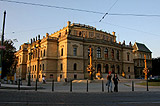From M to ZZZ: Contemporary Latvian Art in the Langhans Gallery
Dec 30, 15:29 Filed under prague-events
In the basement there is an installation consisting of three projecting units and three large screens. The project is called Solitude and was created by Katerina Neiburga.
What you see are stills, combined so that they resemble shots, showing you an untidy apartment. The series of photographs move, mostly one or two at a time. They show you the home, various objects, mostly deserted, only with parts of human bodies often reaching into the frame. You may hear sounds of a common household in the background: people talking in another room, children, doors slamming etc. Then the pictures move to the streets as our “narrator” drives a car. There is an effective illusion of movement and a lot of street noise. It takes about ten minutes, requires a bit of patience, but it’s worth it.
Solitude and emptiness are recurring themes in the following exhibits. Sometimes it is quite explicit. Other parts of the exhibition also deal with photographs, films stills and their combinations. On the first floor there are some impressive photos (by Inta Ruka) and some, in my opinion, over- stylized photo-graphics, which show hollow interiors with people merging with wood. But the most attractive object here is a screen, showing very short “films” by Arnis Balcus. These are black and white, told in stills and clearly inspired by B- movies and 70’s cheap action thrillers. It’s funny and imaginative, with a nicely eclectic musical score.
There is also an LP, which consists of two broken LPs glued into one. One half is a Soviet propagandist song, other is an Latvian folk song, which you can also listen to in a provided CD player. The resulting effect is pretty bizarre: you always hear about a second of one and then a second of the other. Since it’s mostly a pompous choral and a slow, modest ballad, it sounds strange indeed.
In the last room there are more photos, including a series of fictional film stills- photographs stylized in the way that they resemble frozen frames of a film. What you see are results of Andrej Grants’s project ZZZ. The first part of the exhibition’s name is provided by M by Girts Korps. An experimental video project catches most of your attention in the last room. It combines video and photograph into a layered visual product. It’s quite difficult, supplied with appropriate, but not really pleasant, noise music, and definitely not recommended for epileptics.
This short summary doesn’t do justice to the authors of this inspiring exhibition. It is often quite avant- garde (if the word itself isn’t already an anachronism) and it definitely requires patience and will to accept something new.
The Langhans Gallery was opened in 2003 on the same premises that were accommodated by Jan Langhans (1851- 1928), a very famous photographer of his time. The gallery aims to promote progressive art forms and combinations of various formats. The entrance is quite cheap. The full admission is 60Czk and it’s a pleasant little place.
 There is an interesting exhibition you can visit in City Gallery Prague, which is situated in the 4th floor of the main building of the
There is an interesting exhibition you can visit in City Gallery Prague, which is situated in the 4th floor of the main building of the  If you are really interested in design, you definitely should not miss out
If you are really interested in design, you definitely should not miss out  If you are a fan of photography – whatever if as an active photography maker or better admirer of pictures taken by others or, which is the best, you like both – Langans Pallace is a place which you should not miss you are to stay in Prague for some longer time.
If you are a fan of photography – whatever if as an active photography maker or better admirer of pictures taken by others or, which is the best, you like both – Langans Pallace is a place which you should not miss you are to stay in Prague for some longer time.  Works by Austrian artist Gottfried Helnwein are now
Works by Austrian artist Gottfried Helnwein are now 
 The chateau hosts a permanent exhibition of Asian art. The ground floor is mostly Japanese. Every room is supplied with a thorough, well- written commentary in Czech and English; each room is mostly devoted to a single theme, period or a major technique. The various influences are interesting, for example the similarities between 19th Century Japanese ceramics and the European art noveau decorations, or the very early hints of the comic- book style of drawing. There are some very old sheets with of a storyboard- like character, where a series of pictures tells the story of an ancient legend, the short comments written on a side.
The chateau hosts a permanent exhibition of Asian art. The ground floor is mostly Japanese. Every room is supplied with a thorough, well- written commentary in Czech and English; each room is mostly devoted to a single theme, period or a major technique. The various influences are interesting, for example the similarities between 19th Century Japanese ceramics and the European art noveau decorations, or the very early hints of the comic- book style of drawing. There are some very old sheets with of a storyboard- like character, where a series of pictures tells the story of an ancient legend, the short comments written on a side.  On the wall there are advertising posters-like looking pictures of some people. Maybe you do not know them, but they are important personas of Czech political or economical life. There is
On the wall there are advertising posters-like looking pictures of some people. Maybe you do not know them, but they are important personas of Czech political or economical life. There is  On 10th of April started an interesting exhibition in
On 10th of April started an interesting exhibition in  Dresser was also very interested in botany and in investigating botanical natural laws, which then reflected in his work. And what is very important, he visited Japan. Japan was a country, which was for the long time completely closed to Europeans. When it finally opened its boarders, its culture was extremely fascinating and inspiring for Europeans. Dresser came here for few months, was welcomed by the emperor himself, and studied here Japanese Art and culture and was also an advisor in the questions of modern trade. Then there obviously was a strong Japanese influence to be found in his work, some of his designs even were direct copies of Japanese originals.
Dresser was also very interested in botany and in investigating botanical natural laws, which then reflected in his work. And what is very important, he visited Japan. Japan was a country, which was for the long time completely closed to Europeans. When it finally opened its boarders, its culture was extremely fascinating and inspiring for Europeans. Dresser came here for few months, was welcomed by the emperor himself, and studied here Japanese Art and culture and was also an advisor in the questions of modern trade. Then there obviously was a strong Japanese influence to be found in his work, some of his designs even were direct copies of Japanese originals.